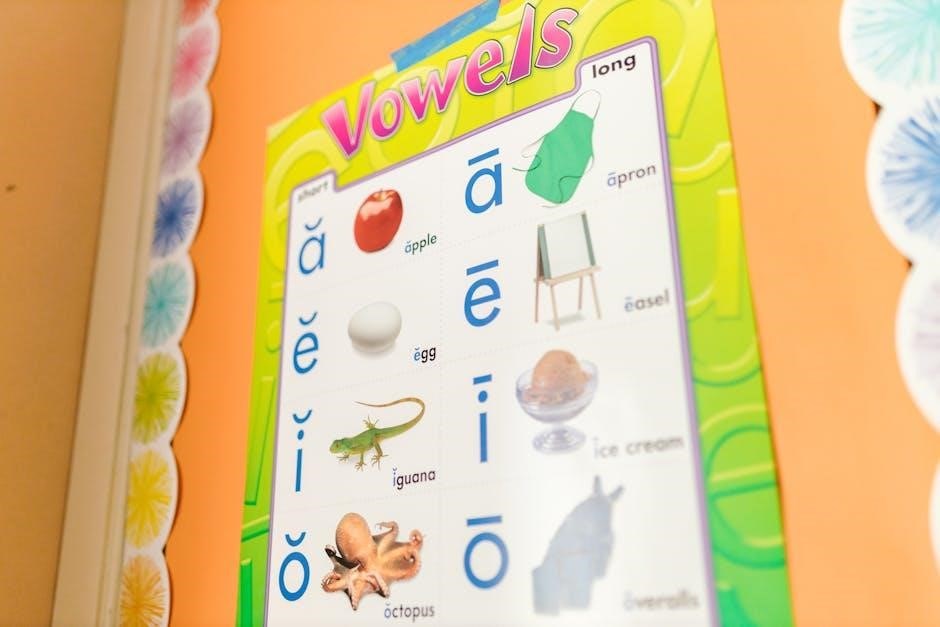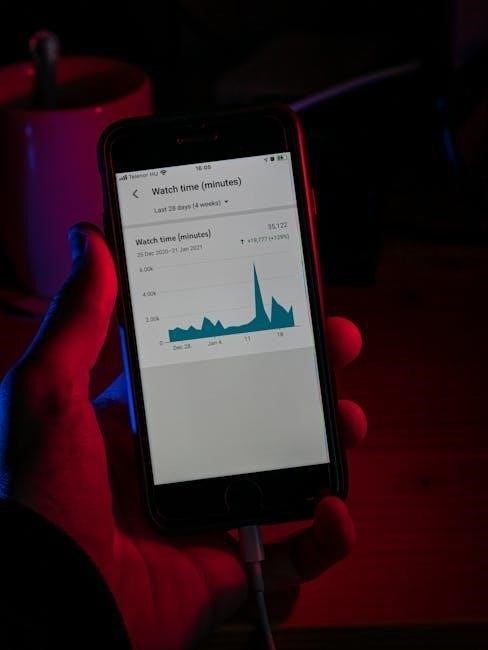Charts are powerful tools for visualizing data, helping users understand complex information at a glance․ They are essential for presenting trends, patterns, and relationships in various fields, from aviation to business analytics․ This guide provides an overview of chart types, creation, customization, and interpretation, ensuring clarity and effectiveness in data communication․ Whether for flight navigation or data analysis, charts simplify decision-making processes․ Explore how to leverage charts to enhance your workflow and gain actionable insights․
What Are Charts?
Charts are visual representations of data, designed to simplify complex information into easily understandable formats․ They use symbols, colors, and axes to display trends, comparisons, or distributions․ From line charts to pie charts, they offer versatile ways to communicate insights․ Charts are essential tools in aviation, business, and analytics, helping users grasp patterns and relationships quickly․ Their clarity and precision make them indispensable for decision-making and presentations․ Charts transform raw data into meaningful, actionable visuals․
The Importance of Charts in Data Visualization
Charts are fundamental tools for effectively communicating data insights․ They simplify complex information, making it accessible and understandable for diverse audiences․ By visually representing trends, patterns, and relationships, charts enable quick decision-making and enhance presentations․ In fields like aviation, business, and analytics, charts are indispensable for conveying critical information․ Their ability to transform raw data into clear, actionable visuals ensures they remain a cornerstone of data visualization, fostering clarity and driving informed decision-making across industries and applications․

Types of Charts
Charts come in various types, each tailored for specific data visualization needs․ Common types include line charts, bar charts, pie charts, scatter plots, and area charts․ They help present data effectively․
Line Charts
Line charts are ideal for displaying trends over time or across categories․ They connect data points with lines, making it easy to identify patterns, increases, or decreases․ Often used for time-series data, such as temperature, stock prices, or sales growth, line charts provide a clear visual representation of changes․ Multiple lines can be added to compare different datasets, enhancing analytical capabilities․ Their simplicity and effectiveness make them a popular choice for tracking trends and predicting future outcomes․
Bar Charts
Bar charts are a popular data visualization tool used to compare quantities across different categories․ They consist of rectangular bars of varying lengths, each representing a specific data point․ This chart type is particularly effective for displaying discrete data, such as sales figures, survey results, or productivity metrics․ Bar charts can be oriented vertically or horizontally, making them highly versatile for different presentation needs․ Their clear and straightforward design helps users quickly identify trends and differences between categories․
Pie Charts
Pie charts visually represent data as slices of a circle, each slice proportionate to its value․ They are ideal for showing parts of a whole, such as market shares or expense categories․ The circular design makes it easy to understand percentages and proportions at a glance․ However, pie charts are less effective for comparing multiple categories or precise data points․ They are best used for simple, high-level overviews, ensuring clarity and quick comprehension of data distributions․
Scatter Plots
Scatter plots display data points on a grid to visualize relationships between two variables․ They are ideal for identifying correlations, patterns, or outliers․ Each point represents a data pair, plotted on x and y axes․ Scatter plots are widely used in analytics and science to explore data relationships․ They are particularly effective for showing distributions, trends, and exceptions, making them a valuable tool for both exploratory and explanatory data analysis․ This chart type helps uncover insights that might be hidden in raw data․
Area Charts
Area charts display data as filled areas below a line, emphasizing magnitude and trends over time․ They are ideal for showing cumulative totals or comparing multiple categories․ By filling the space between axes and lines, area charts highlight changes in values, making patterns and trends more apparent․ They are particularly useful for illustrating progress, sales growth, or resource allocation․ Customization options include choosing colors, adding markers, and stacking areas to compare datasets effectively․ This chart type enhances visual understanding of data distribution and progression․

Creating Charts
Creating charts involves preparing data, selecting the right type, and using tools like Excel or Python libraries to present information clearly and effectively․
Preparing Data for Chart Creation
Preparing data for chart creation involves organizing, cleaning, and formatting your dataset to ensure accuracy and relevance․ This step includes removing duplicates, handling missing values, and transforming data into a suitable structure․ Proper data preparation enhances clarity and ensures charts effectively communicate insights․ Use tools like Excel or Python libraries to streamline this process, ensuring your data is ready for visualization․
Choosing the Right Chart Type
Choosing the right chart type is crucial for effectively communicating data insights․ Different charts serve specific purposes: line charts for trends, bar charts for comparisons, pie charts for proportions, and scatter plots for relationships․ Selecting the appropriate chart ensures clarity and alignment with your data story․ Consider the nature of your data, the message you want to convey, and your audience’s needs․ Refer to chart guides or tools like Excel or Tableau to help make an informed decision and enhance visual storytelling․
Using Chart Creation Tools
Utilizing chart creation tools like Excel, Google Charts, or Tableau simplifies the visualization process․ These tools offer intuitive interfaces for designing interactive and dynamic charts․ Python libraries such as Matplotlib or Plotly also provide advanced customization options․ Refer to user guides or tutorials for step-by-step instructions on creating charts tailored to your needs․ Explore features like real-time data integration, templates, and documentation to enhance your charting experience and produce clear, impactful visuals for presentations or analysis․

Customizing Charts
Customizing charts enhances data presentation by adding titles, labels, and modifying colors and fonts․ Tools like Excel, Google Charts, and Python libraries simplify these adjustments․
Adding Titles and Labels
Adding titles and labels to charts enhances clarity and context, making data easier to understand․ Titles provide an overview, while labels detail axes and data points․ Tools like Excel, Google Charts, and Tableau offer straightforward options to customize these elements․ Use clear, concise language and appropriate fonts to ensure readability․ Labels should be precise, avoiding ambiguity․ This step is crucial for professional presentations and effective data communication, ensuring viewers grasp the chart’s purpose and meaning instantly․ Proper titling and labeling are foundational to creating impactful visualizations․
Customizing Colors and Fonts
Customizing colors and fonts in charts enhances visual appeal and professionalism․ Use complementary colors to differentiate data points and ensure readability․ Select fonts that are clear and consistent with your presentation style․ Tools like Excel, Google Charts, and Tableau offer extensive customization options․ Adjust color palettes to highlight trends or categories, and choose font sizes that maintain balance․ Avoid overwhelming the chart with too many colors or fonts․ Consistency is key to maintaining a polished and professional appearance in your visualizations․
Modifying Chart Legends
Chart legends are crucial for explaining data series, ensuring clarity․ Customize legends by adjusting their position, font, and color․ Tools like Excel, Tableau, and Chart․js allow repositioning legends to avoid overlapping data․ Use consistent font styles and sizes for readability․ Colors in legends should match data points for easy association․ Remove unnecessary entries to simplify the chart․ Ensure the legend is easily distinguishable from the chart area․ These adjustments enhance readability and improve the overall effectiveness of your visualizations․
Adding Interactive Elements
Enhance your charts by incorporating interactive elements such as tooltips, zooming, and hover effects․ Tools like Google Charts, Tableau, and Chart․js support these features․ To implement, enable event listeners for user actions like clicks or hovers․ Use callbacks to trigger additional data displays or animations․ Interactive elements improve user engagement and facilitate deeper data exploration․ Ensure compatibility with various devices and browsers for a seamless experience․ This approach transforms static charts into dynamic, user-driven visualizations, fostering better understanding and decision-making․

Interpreting Charts
Charts simplify data interpretation by visualizing trends, patterns, and relationships․ Understanding axes, scales, and legends is crucial for accurate analysis and informed decision-making․
Understanding Chart Axes and Scales
Chart axes and scales are fundamental for accurate data interpretation․ Axes provide reference lines (x and y) for plotting data, while scales define the measurement intervals․ Properly set scales ensure data is displayed proportionally, avoiding distortion․ Consistency in scaling across charts is crucial for comparisons․ Axes labels clarify the data dimension, and gridlines enhance readability․ Adjusting scales can highlight trends or patterns, but over manipulation risks misrepresentation․ Understanding these elements is vital for interpreting charts effectively and making informed decisions․ Best practices include avoiding unnecessary 3D effects that obscure scale accuracy․
Reading Chart Legends and Keys
Chart legends and keys are essential for understanding the symbols, colors, and labels used in a chart․ They provide clarity by explaining what each data series represents, ensuring accurate interpretation․ Legends typically appear outside the chart area to avoid clutter, while keys are often integrated within the chart․ Properly designed legends enhance readability and prevent confusion․ They are particularly important in multi-series charts or when using complex symbology․ Always refer to the legend to decode the data accurately and make informed decisions based on the visualized information․ Consistency in legend formatting is key for clear communication;
Identifying Trends and Patterns
Charts are invaluable for identifying trends and patterns in data, enabling users to uncover insights and make informed decisions․ Line charts and scatter plots are particularly effective for spotting trends over time or across categories․ Interactive charts allow zooming and hovering to explore data in depth․ Consistent use of colors and labels ensures clarity․ By analyzing these visual representations, users can detect relationships, forecast future behaviors, and optimize strategies based on actionable data insights․

Chart Tools and Software
Popular chart tools include Microsoft Excel, Google Charts, Tableau, and Python libraries like Matplotlib․ These tools offer advanced features for creating interactive, customizable, and professional-quality visualizations efficiently․
Microsoft Excel Charts
Microsoft Excel is a versatile tool for creating dynamic charts to visualize data․ It supports various chart types, including line, bar, pie, and scatter plots, making it ideal for diverse data representation․ Users can easily customize charts by adding titles, labels, and legends, enhancing clarity and readability․ Excel also offers features like data series formatting, color customization, and interactive elements such as drill-down capabilities; With its user-friendly interface and robust functionality, Excel remains a top choice for both beginners and professionals to create professional-quality charts efficiently․
Google Charts
Google Charts is a powerful tool for creating interactive and dynamic visualizations․ It supports a wide range of chart types, from simple line and bar charts to complex treemaps and geocharts․ With its intuitive API, users can easily customize colors, fonts, and layouts to match their needs․ Google Charts also offers real-time data updates and cross-browser compatibility, making it ideal for web-based applications․ Its ability to integrate with Google Sheets and other tools enhances collaboration and data-driven decision-making for developers and businesses alike․

Tableau
Tableau is a leading data visualization tool that enables users to connect, analyze, and visualize data seamlessly․ It supports various chart types, from simple bar charts to complex maps․ With its drag-and-drop interface, users can create interactive dashboards without coding expertise․ Tableau integrates with multiple data sources, including Excel, databases, and cloud platforms․ Its robust analytics capabilities allow for real-time data exploration and sharing of insights across teams․ This makes Tableau a versatile solution for businesses aiming to transform raw data into actionable intelligence effectively․
Python Libraries for Charting
Python offers powerful libraries like Matplotlib, Seaborn, and Plotly for creating dynamic charts․ Matplotlib is ideal for static visuals, while Seaborn enhances styling for informative plots․ Plotly excels in interactive charts, enabling user engagement․ These libraries integrate seamlessly with Pandas and NumPy, simplifying data manipulation․ They support various chart types, from line and bar charts to heatmaps and 3D graphs․ Python’s charting tools are versatile, catering to data exploration, reporting, and dashboard creation, making them indispensable for both beginners and advanced users in data science and analytics․

Best Practices for Chart Usage
Ensure clarity and simplicity in charts by using appropriate colors, fonts, and avoiding unnecessary elements․ This enhances readability and effectiveness in conveying data insights clearly․
Clarity and Simplicity in Charts
Clarity and simplicity are crucial for effective chart communication․ Avoid clutter by minimizing unnecessary design elements․ Use clear titles, labels, and legends to ensure readability․ Select appropriate colors that enhance data understanding without overwhelming the viewer․ Avoid 3D effects or overly complex visualizations that distract from the data․ Ensure proper scaling and alignment of axes for accurate interpretation․ Simplify data representation to highlight key trends and patterns, making it easier for users to grasp insights quickly and efficiently;
Using Appropriate Colors and Fonts
Choosing the right colors and fonts is essential for clear and professional chart design․ Opt for color palettes that enhance readability, avoiding overly bright or clashing hues․ Ensure good contrast between text and background for visibility․ Use fonts that are clean and legible, such as sans-serif options like Arial or Helvetica․ Avoid overly decorative fonts that distract from the data․ Consistent font sizes and styles help maintain a cohesive look․ Tools like Google Charts and Tableau offer predefined styles to guide your selections effectively․
Avoiding Common Chart Mistakes
Avoid overcomplicating charts with too many elements or colors, as this can confuse viewers․ Ensure axes are clearly labeled and scales are accurate to prevent misinformation․ Steer clear of 3D effects that distort data perception․ Avoid using too many chart types in one visualization, as it can overwhelm the audience․ Always double-check data accuracy and formatting before finalizing․ Use tools like Google Charts or Tableau to guide proper design and ensure clarity in communication․ Following these tips helps create effective and professional charts․

Troubleshooting Chart Issues
Identify common chart issues like data display errors or formatting problems․ Check data accuracy and compatibility with tools․ Use guides for resolving issues effectively and efficiently․
Resolving Data Display Problems
Identify data display issues by checking for incorrect chart configurations or mismatched data types․ Ensure data alignment with chart axes and scales․ Verify that data sources are accurate and properly formatted․ Use diagnostic tools to detect errors in data visualization․ Refer to user guides for specific charting software to address formatting inconsistencies; Restart or refresh the chart to resolve temporary glitches․ Consult support resources or documentation for advanced troubleshooting steps to ensure accurate data representation․
Fixing Chart Formatting Issues
Address formatting issues by adjusting fonts, colors, and layouts to ensure clarity․ Reset chart styles to default settings if customizations cause errors․ Use built-in formatting tools to align elements properly․ Verify that chart titles, labels, and legends are correctly assigned․ Check for overlapping elements and adjust spacing as needed․ Refer to user guides for software-specific solutions․ Ensure consistency in formatting across multiple charts for a polished presentation․ Regularly update charting tools to access improved formatting features and troubleshoot common issues efficiently․
Addressing Compatibility Issues
Ensure charts are compatible across platforms by checking browser and software requirements․ Verify data formats match charting tools to prevent rendering errors․ Use standard file formats like PNG or SVG for universal compatibility․ Test charts on multiple devices to ensure responsive design․ Regularly update charting libraries and tools to maintain functionality․ Consult user guides for troubleshooting specific compatibility problems․ Address version mismatches between software components to ensure seamless integration and optimal performance across different environments․

Advanced Chart Techniques
Explore advanced methods like combining multiple charts, animations, and interactive dashboards to enhance data storytelling․ These techniques offer deeper insights and improved user engagement․
Combining Multiple Charts
Combining multiple charts allows for comprehensive data comparison and analysis․ Tools like Google Charts and Tableau support this feature, enabling users to visualize different datasets side by side․ This technique is useful for showing related metrics or trends, such as revenue vs․ expenses over time․ Ensure synchronization of axes and scales for consistency․ Interactive dashboards further enhance this by allowing users to filter or highlight data across combined charts, providing deeper insights and improving decision-making processes․
Using Animations and Transitions
Animations and transitions enhance chart interactivity by visually guiding users through data changes․ Tools like Chart․js and Tableau support smooth animations for data progression․ Google Charts allows dynamic transitions to highlight trends․ These features engage audiences and make complex data more digestible․ Implement animations judiciously to avoid distractions, ensuring clarity remains paramount․ Use these effects to draw attention to key insights or demonstrate temporal data flows effectively․ This approach elevates presentations and dashboards, making data stories more compelling and accessible․
Creating Interactive Dashboards
Interactive dashboards empower users to engage with data dynamically, enabling real-time exploration and analysis․ Tools like Tableau and Power BI simplify dashboard creation, allowing customization of charts, filters, and visualizations․ These dashboards support drill-down capabilities, tooltips, and responsive designs, enhancing user experience․ By integrating multiple data sources, dashboards provide a unified view of information, fostering informed decision-making․ Regular updates and user-friendly interfaces ensure relevance and accessibility, making interactive dashboards indispensable in modern data analytics and reporting workflows․
Charts are indispensable tools for data visualization, offering insights and clarity across diverse fields․ This guide has explored chart types, creation, customization, and interpretation, emphasizing best practices for effective communication․ Tools like Tableau, Google Charts, and Excel empower users to create dynamic, interactive dashboards․ By mastering these techniques, users can transform raw data into actionable intelligence, driving informed decisions․ As technology evolves, staying updated with charting tools and trends ensures continued success in leveraging data visually for personal and professional growth․



